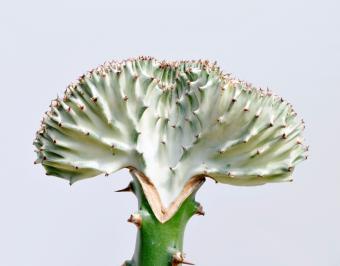Giant Corpse Flower

The plant kingdom contains some truly beautiful and exquisitely unusual specimens. Many unusual plants are difficult to grow at home and are more likely to be seen in a botanical garden, though there are a few that are quite easy to find and care for at home. Several have traits that you wouldn't want in your backyard anyway.
This eight-foot tall arum lily smells like rotting flesh, a scent intended to attract the insects that pollinate it. There are a surprising number of flowers with this peculiar evolutionary trait, though this is certainly the largest. The flower is only fully open for a day or two, but always attracts thousands of admirers (wearing masks to help withstand the stench) to botanical gardens when they bloom.
Big, Beautiful Banyans

Banyans are a type of tropical fig tree with an extremely unusual growth habit. They begin their lives as an epiphyte - a plant that lives off of another plant - but as it grows, rope-like roots descend from the branches, eventually reaching the ground and developing into trunks that give the plant strength to completely consume its host. The largest banyans can colonize an area the size of a city block with a labyrinth of trunks and dangling roots.
A Camouflage Succulent

What appears to be the larger pebbles in this photograph are actually tiny succulents called lithops, also known as stone plant. These are native to the deserts of Africa, but there are dozens of colorful varieties available to decorate terrariums at home. They grow very slowly, but despite their miniscule aboveground portions, they are said to have an extensive root system.
Ancient Conifer

Monkey puzzle trees are native to South America, where indigenous people have subsisted of the nuts found inside their football-sized pinecones for millennia. They reach 150 feet or more in height and can live for over 2000 years. The species is considered a living fossil, as fossil records show that its form has not evolved for at least 160 million years. The symmetrical, fractal-like growth pattern is truly out of this world.
Living on Air

Air plants absorb minute quantities of moisture and nutrients from the air, meaning they do not require soil. In nature they grow on the side of trees, but they can live indoors anywhere with diffused natural light - sitting on a table or hanging by a string from the ceiling. They just need an occasional spritz from a spray bottle to stay moist, which can be augmented with a very diluted quantity of liquid fertilizer to keep them growing.
Living Legends

The baobab trees of sub-Saharan Africa live up to 3000 years and are revered for their profoundly beautiful presence, as well as their many uses. The 6 to 8 inch diameter fruits are edible and their husks have a hard shell that is useful as a bowl, while the bark is used for basketry and rope-making. The hollow trunks of the older trees fill up with water and are used by both people and animals in times of drought.
Massively Itchy

Hogweed is impressive based on it sheer size, growing 15 to 20 feet from the base each year with flower heads up to two feet across. The really scary part is what happens of you come into contact with the sap of the plant. A few days later you will start develop massive, stinging, itchy blisters that resemble the lesions suffered by people who have been badly burned. The sap of hogweed is phyto-toxic, meaning when the skin is exposed to the sun, it is as if it is being burned by flames.
Death by Vegetation

Pitcher plants have modified leaves that form a watertight vessel. They secrete a sweet nectar from glands near the rim of the 'pitcher' to attract insects, many of which find themselves sliding down the slippery foliage into the vat of digestive acids that awaits them at the bottom. Here they experience a slow and miserable death as the acids eat away at their flesh, supplying the pitcher plant with nutrients in the process.
Fast Death

Venus flytraps are native to the coastal swamps of North and South Carolina. Unlike the pitcher plants that take a passive approach to catching insects, flytraps are fast. When an unsuspecting bug lands on its modified, mouth-like leaf it snaps shut in a fraction of second before the poor creature knows what hit it - then the death by digestive juices begins.
Sign up for our newsletter featuring all the latest stories and products we love.
Weathered and Worn

Welwitschia is a tree native to nearly rainless deserts in Africa. The trunk grows only a few inches tall even after many years and it produces a total of two leaves over the course of its entire life. The leaves grow continually from their base at the trunk, while the ends become withered and frayed by the desert winds, making it look as though it is half dead at all times.
Alien Life Form

Some plants, like this variety of euphorbia, look like they belong on Mars rather than planet Earth. This plant owes its appearance in part to human ingenuity - the white fan shape is actually grafted onto a different species of euphorbia for an incredibly cool-looking Frankenstein effect.
Giant Amazonian Lilies

With floating pads up to eight feet in diameter, this is the largest species of lily in the world. The flowers are the size of a dinner plate and open for only two days each year. On the first day the flower is female and uses its scent to attract pollinating beetles which it engulfs live and whole when it closes at nightfall. Overnight it develops male flower organs and the beetle pollinates the flower the next day as it tries to escape.
The world's most unusual plants - whether tiny, giant, fragrant, poisonous, or simply strange-looking - are a neverending source of inspiration and intrigue.







